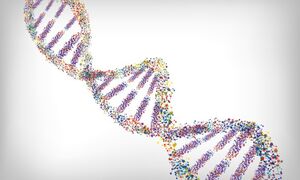Genomic Medicine
We're working in partnership with NHS England and the NHS Genomic Medicine Service to develop a personalised and predictive healthcare solution through the use of genomics.

An introduction to genomes
Your genome is the instructions for making and maintaining you. It is written in a chemical code called DNA. All living things – plants, bacteria, viruses and animals – have a genome.
Find out more about how your genome works in this short video by Great Ormond Street Hospital.
The building blocks of genomes
Your genome is all 3.2 billion letters of your DNA. It contains around 20,000 genes.
Genes are the instructions for making the proteins our bodies are built of – from the keratin in hair and fingernails to the antibody proteins that fight infection.
Genes make up about 1-5% of your genome. The rest of the DNA, between the genes, used to be called ‘junk’ DNA. It wasn’t thought to be important. But we now know that DNA between genes actually regulates the genes and the genome. And there is still much more to learn about what it all does.
That's where genomics comes in.
Genomics looks at the complete genome – that is, all of your DNA from genes to 'junk' – to get a fuller picture of how it can affect our health.

Genomics dictionary
Use this quick guide to learn the definitions of some key genomics terms
DNA
DNA (deoxyribose nucleic acid) is a long molecule. It has a twisted, double helix shape. DNA is made up of four different chemicals, or bases. These are represented by the letters A, T, C and G. The bases are attached to two phosphate backbones. The bases are paired together; A with T, G with C. The two backbones twist around each other to give the characteristic double helix.
As well as being helix shaped, DNA is tightly packed so it takes up less space. If you stretched the DNA in one cell all the way out, it would be about 2m long.
Why sequence a genome?
Learning more about genomes can help us to identify the cause of genetic diseases.
Some rare diseases are caused by as little as a single change (variant), like a spelling mistake, in someone’s DNA. Looking at the genome of a person affected by a rare disease can help find which DNA changes might be causing the problem.
In cancer, the tumour cells have developed a different genome to the healthy cells. Comparing the normal and cancer genomes may give clues about ways to treat the cancer.
For some patients, knowing more about their genome may mean that a particular treatment can be recommended.
When the genome sequences of patients with the same condition are compared, it is possible to see patterns. These patterns can be put together with health information. Once this is done we may be able to link particular patterns with whether people are likely to become ill and, if so, how severe their illness is likely to be.
How sequencing a genome works
1. Test offered
Patients with specific medical conditions may be offered a genomic DNA test via the NHS Genomic Medicine Service.
2. Sample gathered
If they consent, their DNA is extracted from a sample (blood, tissue, or skin) in an NHS laboratory and loaded onto a sequencing machine.
3. Sample sequenced
The machine determines the sequence of short pieces of DNA, 150 letter long, called 'reads'.
4. Sequence mapped
The 'reads' from the machine are matched to a reference sequence. This is called 'mapping'.
5. Variants analysed
'Variants' in the DNA are analysed by bioinformaticians and narrowed down to just a handful that could be harmful.
6. NHS receives list of variants
These handful of variants are fed back to the NHS laboratory, whose scientists look through the list of variants and compare them to a patient’s symptoms and health data.
7. NHS confirms results
Any findings are given to the patient’s clinician. If a variant is confirmed to be the cause of a condition, diagnosis and implications are discussed with the patient.


